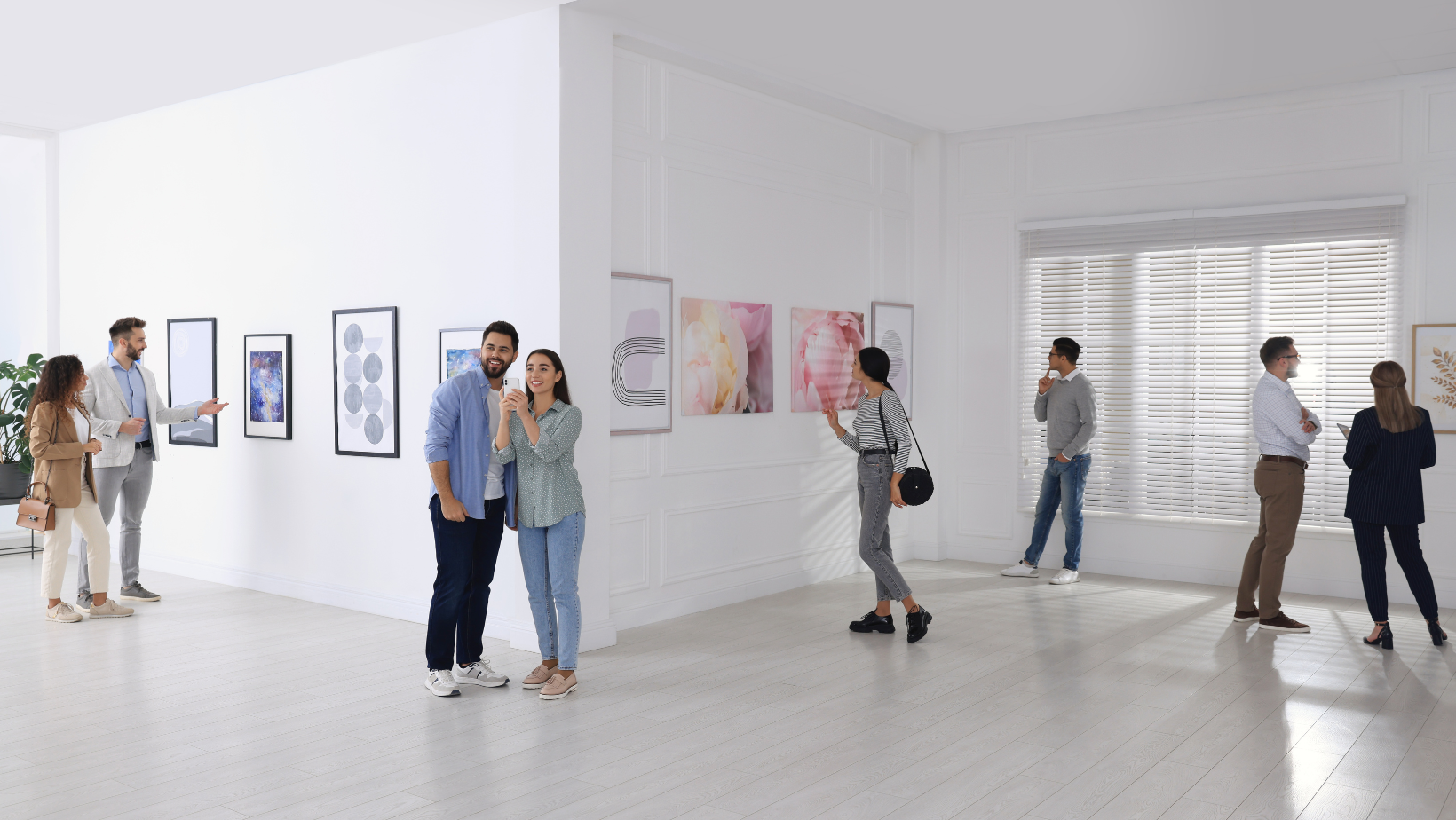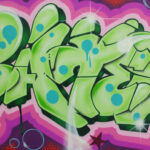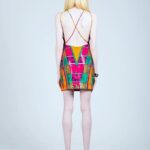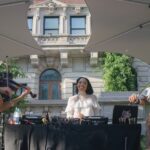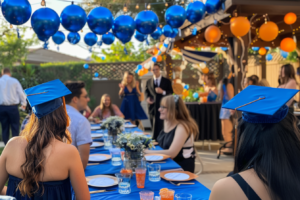Introduction
The journey of organizing an art exhibition is both exhilarating and challenging, encompassing a spectrum of roles from the emerging artist to the seasoned art gallery owner, and the enthusiastic art lover. Each step, from conceptualizing to staging the actual art show, demands meticulous planning and effective communication. In this digital era, tools like Hobnob have revolutionized the way these events are managed, making the process streamlined and interactive.
In the dynamic art world, whether it’s a solo exhibition by a budding artist or a large-scale art fair booth curated by an experienced gallery owner, each event requires a tailored approach. It’s not just about selecting and arranging artworks; it’s about creating a narrative that resonates with the target audience, whether they are local artists, art collectors, or general art enthusiasts. This involves careful consideration of the exhibition space, ensuring it enhances the visual art on display.
The role of digital solutions like Hobnob in this process is pivotal. This app simplifies tasks such as sending out digital invitations, managing RSVPs, and communicating with attendees, which is crucial for art gallery businesses. It allows for effective promotion and engagement, tapping into social media and online platforms, thus broadening the reach and impact of the exhibition.
Understanding the Art Exhibition Landscape
The art exhibition landscape is a rich tapestry, intricately woven from the threads of artistic expression, curatorial expertise, and collector enthusiasm. Whether it’s the intimate setting of a solo show, the collaborative energy of a group exhibition, or the bustling diversity of a grand art fair booth, each type of art event offers a unique window into the world of visual arts.
A solo exhibition is often a defining moment for an artist. It is an opportunity to present a cohesive body of work, often telling a personal or thematic story. This format allows the artist to make a profound statement, connecting deeply with the audience. For emerging artists, a solo show can be a significant stepping stone, marking their entry into the professional art world and attracting the attention of art collectors and galleries.
In contrast, a group exhibition is a confluence of diverse artistic voices. It presents a chance for artists to showcase their work alongside their peers, creating a dialogue between different styles, techniques, and perspectives. These exhibitions are often curated around a specific theme or concept, allowing for a rich exploration of ideas. They are also vital for community engagement, bringing together local artists and fostering connections within the art community.
Art fair booths, on the other hand, offer a more commercial perspective. They are spaces where gallery owners and artists can reach a wider audience, including international collectors and art enthusiasts. These fairs are important for networking, building relationships, and staying abreast of current trends and market dynamics in the art world. They are also a platform for emerging and established artists to gain visibility and for art collectors to discover new talents or add to their collections.
Each of these exhibition types contributes to the vibrant mosaic of the art exhibition landscape. They serve different purposes and cater to varying audiences, but all share the common goal of celebrating and promoting art. From the careful curation of artwork to the meticulous planning of the exhibition space, every aspect of organizing these events is crucial. They provide a stage for artists to share their visions, for curators to weave narratives, and for art collectors and enthusiasts to engage with and appreciate the beauty and diversity of art.

The Role of Careful Planning
In the realm of art exhibitions, the significance of careful planning cannot be overstated. This process is multifaceted, involving various elements that collectively contribute to the success of the event. The choice of venue, for instance, is a critical decision that sets the tone for the entire exhibition. It’s not just a physical space, but a canvas that should enhance and complement the visual art on display. The venue’s ambiance, architecture, and location are all factors that influence the experience of the attendees. It should be a space that harmonizes with the art, whether it’s a traditional gallery space, a contemporary art center, or an unconventional pop-up area.
Beyond the selection of the venue, the arrangement and presentation of the artwork are crucial. This includes considering the lighting, which can dramatically alter the perception of the art. Proper illumination is essential for highlighting the nuances of paintings, the contours of sculptures, and the intricate details of mixed media pieces. The layout of the exhibition is another pivotal element. The flow of the space should guide the viewer naturally through the artworks, creating a narrative or thematic journey that enhances their understanding and appreciation of the art.
Curating the artwork is a task that demands a deep understanding of both the artist’s intent and the target audience’s preferences. Each piece, whether it’s a large-scale installation or a small, intricate work, needs to be selected and positioned in a way that speaks to the theme of the show. This curation process is about storytelling, where each artwork contributes to a larger narrative.
Moreover, successful exhibition planning also involves logistical considerations such as marketing, publicity, and audience engagement strategies. It’s about creating a buzz around the event, reaching out to art critics, influencers, and the media, and ensuring that there is a steady conversation about the exhibition in the lead-up to its opening. Social media plays a pivotal role in this, providing a platform for teasers, previews, and behind-the-scenes glimpses of the exhibition setup.
In addition, engaging with the local art community is vital. This may involve organizing previews, artist talks, or workshops in conjunction with the exhibition. These events not only enhance the exhibition experience but also foster a sense of community and dialogue around the art.

Incorporating Technology: Hobnob
In today’s digital era, the integration of technology, particularly tools like Hobnob, plays a crucial role in enhancing the success of art exhibitions. Hobnob extends beyond being a mere digital invitation app; it’s a multifaceted platform that revolutionizes communication between artists, gallery owners, and art enthusiasts.
This comprehensive tool streamlines the process of managing guest lists and RSVPs, enabling efficient and direct engagement with attendees. Its chat feature fosters a more personal connection, allowing for real-time interactions and updates. This is especially useful for conveying last-minute changes or sharing exclusive previews of art pieces.
Moreover, Hobnob’s ability to instantly share updates and organize photos is invaluable in the art world, where visual engagement and timely communication are key. These features not only keep the audience informed but also enhance the promotional efforts on social media, broadening the reach of the exhibition.
Marketing and Promotion: A Key to Successful Exhibition
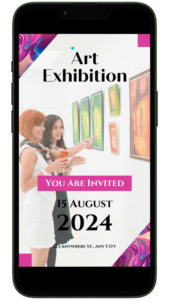
In the vibrant and competitive arena of art exhibitions, a well-crafted marketing and promotion strategy is indispensable for success. Whether it’s for an avant-garde solo show at a local art gallery, a high-profile group exhibition, or a bustling art fair booth, effective marketing is what bridges the gap between the art world and its audience.
The core of a successful marketing strategy lies in its ability to generate excitement and anticipation. Utilizing social media platforms is a key component, offering a dynamic and interactive way to create a buzz around an upcoming art show or exhibition. For an art gallery owner or curator, social media provides an invaluable tool to showcase sneak peeks of artwork, share artist statements, and post recent updates about the event. This not only engages art enthusiasts and collectors but also reaches a wider audience who might be new to the art world.
Sending out press releases is another critical element of the promotion puzzle. Well-crafted press releases can attract the attention of art critics, local and international media, and influential figures in the art world, ensuring wider coverage of the exhibition. This is particularly important for emerging artists and local artists looking to gain visibility and recognition.
Hobnob, with its sophisticated digital invitation capabilities, can play a pivotal role in this marketing mix. It allows organizers to design and send out stylish digital invites, perfect for both exclusive art gallery openings and large-scale art fairs. The app’s functionality extends to managing RSVPs and sending out timely updates to potential attendees, ensuring a high level of engagement.
A successful exhibition also demands regular updates and engagement with art online communities. These platforms can be leveraged to discuss related articles, share insights into the art pieces featured, and even host virtual artist talks. This not only promotes the exhibition but also builds a community of art lovers who are engaged and excited about the event.
Furthermore, careful planning of the exhibition space and layout in the gallery space can also be part of the marketing strategy. By creating an aesthetically pleasing and welcoming venue, organizers can entice attendees and encourage them to share their experiences, thereby organically promoting the event.
Engaging with the Art Community
In the intricate and interconnected world of art exhibitions, the importance of engaging with the art community cannot be understated. A successful exhibition is not just a showcase of artwork; it’s a vibrant hub for building and nurturing relationships that extend beyond the exhibition space. This engagement involves a dynamic interaction with a wide array of individuals and groups, including local artists, art collectors, fellow art gallery owners, curators, and the broader circle of art enthusiasts.
The essence of this engagement lies in creating a network that both supports and promotes the diverse facets of the art world. For emerging artists, this can mean gaining exposure and receiving valuable feedback from seasoned art professionals and collectors. For art gallery owners, it’s an opportunity to collaborate, share insights, and discuss the latest trends and challenges in the art gallery business. And for art collectors, these interactions can lead to discovering new talents and adding unique pieces to their collections.
One effective way to deepen this engagement is by organizing artist talks. These talks provide a platform for artists to share their journey, discuss their art pieces, and reveal the stories and inspirations behind their work. They offer attendees, especially art lovers and aspiring artists, a chance to gain insights into the creative process and the art world at large.
Similarly, hosting discussions on related articles or current topics in the art world can stimulate intellectual engagement and debate among the attendees. These discussions can cover a range of subjects, from art history to contemporary art trends, offering a richer understanding of the context and significance of the artworks on display.
Art history sessions, another enriching component, can add educational value to the exhibition. By exploring the historical background and evolution of certain art styles or movements, these sessions can enhance the appreciation of the artworks and provide a deeper understanding of their cultural and historical significance.
Furthermore, the role of social media and online platforms in engaging with the art community is increasingly crucial. These digital avenues allow for the sharing of recent posts about the exhibition, artist profiles, and behind-the-scenes glimpses, creating an ongoing dialogue with a global audience. They also offer an interactive space for art enthusiasts to share their experiences, thoughts, and reviews of the exhibition, thereby extending the reach and impact of the event.
Post-Exhibition Management
Effective post-exhibition management is as crucial as the careful planning and execution of the art show itself. After the closure of an art exhibition, whether it was a solo show in a boutique art gallery or a sprawling group exhibition in a large gallery space, there are several key actions that gallery owners, curators, and artists should undertake to capitalize on their efforts and lay the groundwork for future success.
One of the primary tasks post-exhibition is to gather feedback from attendees. This feedback is invaluable for evaluating the impact of the exhibition and understanding the reception of the artwork and the overall event. Tools like Hobnob can be instrumental in this process, enabling organizers to easily collect thoughts, impressions, and photos from attendees. This data can provide insights into what worked well and what could be improved, shaping strategies for future exhibitions.
Managing art sales effectively is another critical aspect of post-exhibition management. For many artists and galleries, sales are a key indicator of success. It is important to follow up with art collectors and attendees who showed interest in purchasing artwork. This not only helps in closing sales but also in building relationships with collectors who may become regular patrons.
Keeping the conversation going after the event is vital for maintaining engagement with the art community. Utilizing social media platforms to share post-event updates, highlight pieces that were sold, and acknowledge participants and attendees helps keep the momentum going. Sharing related articles, artist interviews, and reviews of the exhibition can further stimulate interest and discussion.
Additionally, for art gallery businesses, post-exhibition is an optimal time to update their online presence with recent posts and images from the event. This not only serves as a record of past successes but also as promotional material for the gallery’s capabilities and range.
For curators and artists, reflecting on the exhibition is important. This includes reviewing the exhibition planning process, from the choice of venue to the marketing strategy employed. Understanding the dynamics of the target audience, the effectiveness of the exhibition space layout, and the reception of individual art pieces or artist statements can provide valuable lessons.
Furthermore, for emerging artists, post-exhibition offers a chance to update their portfolios with recent art work and exhibition history, a crucial step in building their professional profile. It’s also an opportunity to network with other artists, curators, and gallery owners, fostering relationships that can lead to future collaborations.
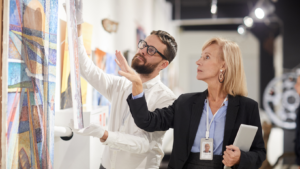
Conclusion: The Art of Crafting Memorable Exhibition
In conclusion, the journey of organizing a successful art exhibition, whether it’s an intimate solo show by an emerging artist or a grand display at a bustling art fair, is a complex blend of creativity, meticulous planning, and strategic execution. It encompasses various facets, from the initial concept of the art show to the final moments of post-exhibition management. Each step, be it in a traditional art gallery setting or a contemporary exhibition space, demands attention to detail and a deep understanding of the art world.
Embracing modern technology, like the innovative features of Hobnob, plays a crucial role in this process. It transforms how we invite attendees, engage with our target audience, and manage the dynamics of art gallery business. The use of such digital tools, coupled with the power of social media, amplifies the reach of the exhibition, allowing art gallery owners, curators, and artists to connect with a broader audience that includes art collectors, local artists, and art enthusiasts.
Engaging effectively with the art community is another cornerstone of organizing a successful art exhibition. It involves not just showcasing artwork but also creating a platform for artist talks, discussions on art history, and the sharing of artist statements. These interactions enrich the exhibition, making it more than just an event but a hub for cultural exchange and inspiration.
Remember, each art piece, whether a painting, sculpture, or mixed media work, is imbued with a story waiting to be told. Each exhibition is an opportunity to bring these stories to light and share them with the world. It’s about creating a memorable experience that resonates with art lovers, sparks conversations, and fosters connections.
This journey, from careful planning in selecting the venue and curating the artwork to the final stages of art sales and post-exhibition engagement, is a testament to the dedication and passion that fuel the art gallery business. It’s a collaborative effort that involves artists, gallery owners, curators, and attendees, all coming together to celebrate the beauty and diversity of art.
In essence, the goal is to make each art show, each exhibition space, and each art fair booth a unique and memorable experience. Whether it’s a solo exhibition showcasing the journey of an emerging artist or a group exhibition that brings together diverse art pieces, the aim is to create lasting impressions and meaningful connections.
As we navigate the evolving landscape of the art world, let’s continue to embrace innovation, engage deeply with our communities, and share the captivating stories that each artwork holds. Let’s commit to making every art exhibition a testament to the power of visual art, a celebration of creativity, and a gathering place for art lovers from all walks of life.
